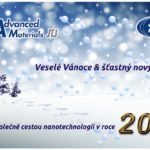
The New York Times zveřejnily článek Jacy Meyer „To Czech Industry, Everything Is Nano“
To Czech Industry, Everything Is
Nano
By JACY MEYER
PRAGUE — Nanotechnology is a young but rapidly developing field that exploits the strange physical properties possessed by microscopic particles about one 800th the
thickness of a human hair.
The high surface area of a nanoparticle relative to its weight and volume makes it behave differently from larger masses of the same material. Over the past decade or so
researchers have been developing nanotechnology applications in a broad range of fields including engineering, electronics, biotechnology, medicine, power generation and
environmental protection.
Industries based on nanotechnology are a rapidly growing niche in the economy of the Czech Republic, which, although small, is widely respected for its technical prowess. In
February, the country had its own pavilion at the International Nanotechnology Trade Fair, Nanotech 2012, in Tokyo. Ten Czech companies took part.
One was Advanced Materials-JTJ, which produces photocatalytic coating materials incorporating titanium dioxide nanoparticles, known as FN coatings. The semitransparent,
odorless coatings have the unusual property of purifying the air around them — removing viruses, bacteria, toxins, cigarette smoke and more through a lightactivated
catalytic process.
“We went for one reason, because the commercialization of photocatalysis started there about 20 years ago. We have optimized the product and wanted to demonstrate it,” said Jan Prochazka, the company’s chief executive.“We made lots of contacts, talked to investors, companies and others, who are using firstgeneration products and want to upgrade.”Over the course of a year, “one square meter of FN-painted facade will clean and decontaminate over three million cubic meters of air,” or 106 million cubic feet, removing several kilograms of pollution, Mr. Prochazka said.
As well as cleaning the air, the coating protects the painted surfaces from mold, fungus and the slow accumulation of dirt deposits that cause erosion and discoloring, he said.
The process, activated by ultraviolet light — that is, sunshine — is both environmentally friendly and cost-effective.
“For many people nano is a question mark, but really, everything is nano, except for gravel, sand and a few other materials,” Mr. Prochazka said in an interview in Prague.
“Take a cup of water; you can’t imagine how many nanoparticles are inside.”
The Czech government is actively supporting the nano industry through the participation of ministries and universities in research and development programs.
At least 26 institutes in the Czech Academy of Sciences, 37 university faculties and nine state-funded research organizations are conducting basic research in various areas of
nanoscience, according to CzechInvest, the country’s investment and business development agency.
Development of applied nanotechnologies is being pursued by at least 15 researchoriented private companies and 69 manufacturers. Several nanotechnology clusters have
also been established, bringing together small or medium-size businesses, academics and researchers. Nanoprogres is one of them.
“We have universities, research and development centers and SMEs,” said Liliana Berezkinova, sales and marketing manager for Nanoprogres, using an abbreviation for
small and medium-size enterprises. “SMEs can access innovation and universities can find people who can bring their ideas to market.
“We pride ourselves on being a cluster with a strong technology transfer focus, business driven. We are looking for products, ” Ms. Berezkinova added.
Nanoprogres has chosen to focus on nano-medicine. Its main product is a coaxial nanofiber with properties that enable it to be used as a carrier for substances that cannot
be carried by more traditional fibers, making it suitable for a range of possible medical applications, like controlled drug delivery systems.
Ms. Berezkinova says nano-medicine is an area that offers particularly exciting possibilities, although one drawback is the relatively long time that it takes to bring new
products to market.
“Applications in industry are further along than in medicine, because not so much testing is required as when you work with human bodies,” she said.
“What we are doing is exciting — the ability to treat disease more gently and efficiently,” she said. “But we have to go through many tests, assurances of safety, and so forth.”
Beside environmental applications, like those developed by Advanced Materials-JTJ, the Czech Republic has a well-developed industrial nanotechnology sector. Peter Hawlan, chief executive of Elmarco, a supplier of industrial-scale nanofiber production equipment, says Czech strength in the sector is a logical extension of the country’s
industrial heritage.
“The nanotechnology industry follows the machinery industry, which has a long tradition in the Czech Republic,” Mr. Hawlan said. “The first industrial-scale nanofiber production equipment was developed in 2004 on the basis of cooperation between Elmarco and the Technical University of Liberec.” The university, in the northern city of Liberec, is one of the country’s leading engineering institutes.
“Now, many small or medium-sized companies and other institutions from the nanotechnology area have been founded and this industry is also strongly supported from
state funds,” Mr. Hawlan said.
Elmarco makes machinery for Nanospider technology, a process for producing a range of organic and inorganic nanofibers.
Its products include laboratory-scale electrospinning equipment for research and development; production lines for low to moderate product volumes and high-volume
machines.
“The technology enables Elmarco to build industrial-scale production equipment without nozzles, needles or spinnerets,” Mr. Hawlan said. The use of Nanospider technology has made it easy to scale up from the laboratory to industrial production, and the technology’s adaptability to high volume production makes it possible to accelerate the
introduction of nanofiber products into the market.
Uses of nanofibers are being explored in areas as varied as medicine, clothing, air and water filtration systems and electrical batteries.
“Nano has always been here — in concrete, mud — the difference is that in the last 20 years we started to see it, now we have the instruments,” Mr. Prochazka said. “Everything is nano and we can use nanoparticles to extend the limits. Nanotechnology will bring us to another world.”
Maybe, but getting there may not be so easy for Czech manufacturers, Ms. Berezkinova noted.
“We have tradition, people and ideas: The Czech Republic is one of the most advanced; we are definitely at the very front,” in developing new applications, she said. “But the
question is, if we can compete at the execution level.”
“The U.S., China, Japan sponsor nanotechnology the most — but we can’t complete with their money,” she said. “We need to find businesses to develop and market the products.
Technology transfer and commercialization is a big challenge: Our outlook is optimistic— but we can’t lose focus.”






